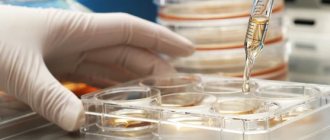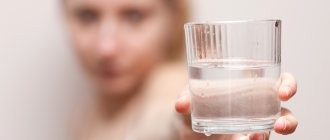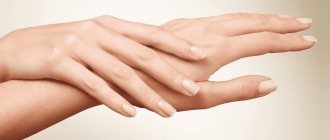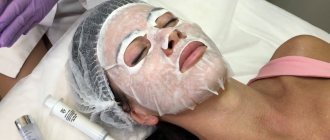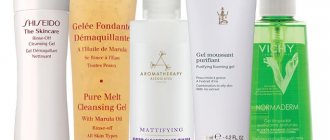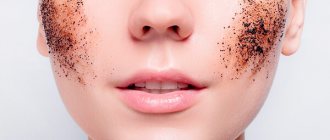What is skin photoaging
Do you have friends who used to bake in the sun for half a day, but now “sunbathe” only in tunics and in the shade? They grew up, came to their senses and read articles about photoaging. Getting to know this topic makes you reconsider your habits.
Photoaging is the premature appearance of age-related changes in the skin due to the influence of ultraviolet rays.
At what age do we begin to see our first wrinkles - at 25-30? And if it weren’t for the sun, this would happen in 40+ years.
And almost each of us looks older than our biological age. We are used to seeing the same people around us and can hardly imagine what a woman would look like if she were not subject to photoaging.
Will you say that you protect your skin from the sun, and with creams with a filter of at least 30 SPF? Well done, that's right. But answer these questions:
- Have you been doing this since birth?
- In winter too?
- In inclement weather?
- And when are you indoors? Imagine the situation: you woke up, you don’t have to go anywhere, you’re at home all day – at such moments too?
The insidiousness of photoaging is that it has a cumulative effect. This is not a one-time photodamage to the skin: burnt, smeared with sour cream, peeled off. And it's not even reusable.
Photoaging is the manifestation of photodamage that the skin has accumulated over a lifetime. Moreover, degenerative changes are caused by both UVB and UVA rays.
Have you heard anything about them? These are the two types of sun rays that reach the surface of the earth.
UVB rays have a stronger damaging effect, but do not pass through clouds and windows - it is easier to protect against them.
UVA rays are more insidious. They are not so strong, but they irradiate us every second during daylight hours, no matter what time of year it is, what the weather is like, and where we are - outdoors or indoors.
State Budgetary Institution of Health Care of Sevastopol “Dermatovenerologic Dispensary”
Solar radiation and its effects on the skin
The main damaging effect on the skin, leading to the appearance of the first signs of aging and their progression, is ultraviolet (UV) radiation. It initiates a degenerative process in the skin, as a result of which it becomes drier and rougher, gradually loses its tone, and wrinkles and age spots appear on it. Changes caused by exposure to UV radiation are called photoaging. The source of ultraviolet radiation is the sun.
Depending on the length of electromagnetic waves, UV radiation is conventionally divided into UVA, UVB and UVC ranges. UVC rays, the rays with the shortest wavelength (200-290 nm), are the most dangerous because they have the highest energy. Fortunately, all UVC rays are blocked by the ozone layer of the earth's atmosphere.
UVB rays with a wavelength of 290 to 320 nm are only partially blocked by the ozone layer and reach the Earth's surface, although they practically do not penetrate glass. A significant part of them (more than 70%) is reflected by the stratum corneum of human skin, and yet some of the UVB rays penetrate into the epidermis, and about 10% even into the uppermost layers of the dermis. These rays have a strong damaging effect. They cause erythema (redness of the skin or sunburn) and tanning, and are responsible for many of the acute and chronic side effects associated with exposure to sunlight.
The wavelengths of UVA rays range from 320 to 400 nm. Of the entire UV spectrum, these rays have the lowest energy, but at the same time the highest penetrating ability. They are not retained by the ozone layer and pass through glass and the stratum corneum of the skin. In human skin, UVA rays reach the middle layers of the dermis and, although they do not cause sunburn, play a leading role in the development of actinic skin damage.
It has now been reliably established that both UV radiation spectra—both UVA and UVB—play an active role in the process of photoaging.
UV radiation triggers photochemical reactions in the skin, the products of which are free radicals and reactive oxygen species. By reacting with other biological molecules - protein, lipid or DNA molecules - they transfer their activity to them. Having thus turned into free and aggressive radicals, they, in turn, begin to react with the molecules surrounding them. In this case, proteins cross-link with each other, lipids of biological membranes are oxidized, and mutations occur in the genetic apparatus of the cell. Free radicals damage the connective tissue of the dermis, keratinocytes, have a negative effect on the vascular system of the skin, and enhance all manifestations of photoaging.
SIGNS OF PHOTOAGING
Premature skin aging begins with connective tissue, where collagen and elastin fibers are located. Collagen provides skin elasticity, and in young people its threads are constantly renewed. The enzyme collagenase destroys old threads, and new ones are synthesized in fibroblasts. Over time, under the influence of UV radiation, collagen synthesis in fibroblasts decreases and cross-linking of collagen filaments occurs. Collagen dimers are inaccessible to collagenase, so they gradually accumulate in the skin. Cross-linking of collagen fibers occurs after each free radical attack, while elastin synthesis increases, which together leads to a decrease in skin elasticity and the formation of wrinkles.
Signs of photoaging can be divided into physiological, clinical, anatomical and histological.
MAIN MANIFESTATIONS OF PHOTOAGING
With intense exposure to UV radiation, already at the age of 35-40 years, people develop signs of skin photoaging. It becomes drier, light wrinkles, pigment spots, and isolated telangiectasias appear. With age, these phenomena steadily progress. Degenerative changes, atrophy, keratosis begin to develop, spots of hypomelanosis (with partially lost pigment), yellow nodules and plaques appear. The listed clinical signs are combined into the concept of dermatoheliosis.
SOLAR ELASTOSIS
The main manifestation of dermatoheliosis is solar elastosis, which develops at the age of 40-50 years and clinically manifests itself as Milian lemon skin, characterized by reticular striations in the form of diamond-shaped slits and grooves against the background of thickened pale yellow skin). The process is usually localized on the face, neck, hands and forearms. As for other parts of the body, solar elastosis can only manifest itself as a yellowish tint to the skin. The disease is steadily progressive and, although not malignant in itself, serves as a marker for other more serious sun-induced skin lesions such as solar keratoses and squamous cell skin cancer.
Simultaneously with solar elastosis, other skin lesions develop as a result of UV irradiation, the number and nature of which may vary depending on the location of the affected area on the body. Such skin lesions include:
- • diamond-shaped skin of the neck;
- • Favre-Rakucho disease;
- • diffuse Dubreuil elastoma;
- • senile hyperplasia of the sebaceous glands;
- • Bateman's solar purpura;
- • O'Brien's actinic granuloma;
- • actinic comedonal plaques;
- • venous lakes;
- • lentigo solar;
- • idiopathic guttate hypomelanosis.
DIAMONDS NECK SKIN
Diamond-shaped skin of the neck (Cutis rhomhoidalis nuchae) clinically manifests itself as thickened, deeply diamond-shaped skin on the back of the neck, as well as yellow plaques. When stretched, this skin is no different from the lemon Milian skin on the face, that is, such a lesion is essentially a pronounced manifestation of solar elastosis in the neck area. Diamond neck skin occurs predominantly in men because women's neck skin is usually protected by hair.
FAVRE-RACOUCHO DISEASE
Intense insolation and wind contribute to the development of Favre-Racouchot disease in men over 50 years of age, which affects the skin of the face, especially the temporal areas and around the ears, as well as the back of the neck. In the lesions, against the background of thickened and compacted skin of a yellowish-red hue, collected in rough folds (phenomena of pronounced solar elastosis), nodular elements with a diameter of 0.5-1.0 cm, cysts with whitish contents with a diameter of 0.1-0.5 are visible cm and comedones, located in the central part of most nodules and cysts. In severe cases of the disease, cysts can merge, forming thickened yellowish plaques with many large comedones.
DIFFUSE ELASTOMA OF DUBREUL
A milder variant of Favre-Racouchot disease, diffuse Dubreuil elastoma, is characterized by the presence of well-defined yellowish plaques in the forehead, cheeks and lateral neck. Sometimes the disease manifests itself as a solitary papule or plaque in the area of the nose or back of the head, consisting of papule-like elements that resemble cobblestones. The skin in the area of the plaque is yellowish, wrinkled, soft, and gradually undergoes atrophy.
SENILE HYPERPLASIA OF THE SEBABY GLANDS
After prolonged intense sun exposure, senile hyperplasia of the sebaceous glands develops, characterized by the appearance of small light yellow papules in the forehead, lower eyelids, cheeks, nose and forearms, which over time acquire a darker yellow tint, a dome-shaped shape and umbilical depressions in the center. When the elements are squeezed, droplets of sebaceous secretion are released from them.
BATEMAN'S SOLAR PURPLE
Long-term exposure to sunlight, which damages fibroblasts around blood vessels and leads to loss of collagen and vascular fragility, is a major predisposing factor in the development of solar Bateman's purpura in people over 60 years of age. The immediate cause of purpura is mechanical trauma, leading to rupture of dilated vessels of the subpapillary venous plexus. Clinically, the disease is characterized by the sudden appearance of hemorrhagic spots of red or purple color with a diameter of 1.0-5.0 cm with clear rugged contours on the back of the hands, extensor surfaces of the shoulders and forearms, and very rarely on the lower extremities or face. The surrounding skin is thin and has reduced elasticity. Due to the presence of hemosiderin in the elements and a decrease in the activity of macrophages, the lesions slowly evolve into pigment spots.
O'BRIEN'S ACTINIC GRANULOMA
O'Brien's actinic granuloma is formed as a result of an inflammatory reaction with a giant cell infiltrate that develops in the dermis in areas of solar elastosis. It most often occurs on the extensor surface of the forearms and upper back in people with fair skin color and the presence of freckles. It begins with the appearance of translucent reddish-brown papules, which gradually enlarge, lighten and turn into ring-shaped elements with a diameter of 1.0-3.0 cm. The skin over them is compacted and smooth. The center of the element is atrophic and depigmented. The elements are usually asymptomatic, but sunburn can cause severe erythema and irritation.
ACTINIC COMEDONA PLACLES
Actinic comedo plaques are single or multiple nodules or plaques localized on the extensor surface of the forearms and face, especially around the eyes and on the upper cheeks. The color of the plaques varies from pink to blue, and comedone-like elements may form against their background.
VENOUS LAKES
Venous lakes are clinically expressed in the appearance of soft blue or purple papules with a diameter of 0.5 cm, disappearing with diascopy. Single or multiple elements are usually located on the lower lip or in the helix area of the auricle, less often on other areas of the skin exposed to sunlight.
LENTIGO SOLAR
Lentigo solaris is the result of local proliferation of melanocytes in the area of the dermoepidermal junction. Clinically, it manifests itself as multiple pigment spots of a uniform light or dark brown, and sometimes black color, located on open areas of the skin and especially noticeable on the face (temples, forehead), the back of the hands and the extensor surface of the forearms. The spots are usually quite large - more than 1.0 cm in diameter, have a round shape and unclear boundaries. Although solar lentigo is the result of cumulative sun exposure, it, unlike freckles, does not darken with exposure to the sun.
According to some authors, the focus of solar lentigo, when basaloid cells spread into the lower layers of the dermis, can turn into a plaque of solar keratosis of the reticular type. In addition, lesions of solar lentigo can become inflamed, becoming the precursors of benign lichenoid keratosis. In very rare cases, long-standing solar lentigo progresses to Dubreuil's limited melanosis, a disease that transforms into melanoma.
TEAR-shaped IDIOPATHIC HYPOMELANOSIS
Guttate idiopathic hypomelanosis is characterized by the appearance of hundreds of asymptomatic depigmented porcelain-white spots with clear edges of a round or star-shaped shape measuring 0.2-0.5 cm, scattered like confetti on the anterior surface of the legs and forearms. The development of the disease is associated with prolonged UV irradiation, leading to a decrease in the number of melanosomes and melanin granules.
One of the dangerous consequences of photodamage to the skin is photocarcinogenesis—malignant degeneration of cells that occurs under the influence of UV radiation. Under the influence of UV radiation, the expression of genes encoding both suppressor proteins and proteins that promote tumor development is disrupted. UV radiation stimulates the production of the protein c-fos, which stimulates cell proliferation. At the same time, constant long-term UV irradiation can cause mutations in the gene encoding the tumor suppressor protein p53. As a result, a discrepancy between cell proliferation, differentiation and apoptosis occurs. With age, the imbalance of these processes worsens, which gradually leads to the development of skin tumors.
MODERN WAYS TO COMBAT PHOTO-AGING OF SKIN
The initial manifestations of photoaging are reversible and with skillful handling of the sun and rational skin care, their regression can be achieved.
To eliminate the phenomena of dermatoheliosis, more active therapeutic measures are needed (the use of systemic and topical aromatic retinoids, peelings, cryotherapy, laser therapy, dermabrasion, surgical excision). Treatment is usually lengthy and in some cases traumatic. In addition, it requires certain financial costs. Unfortunately, especially with already widespread processes, it is not always possible to achieve the desired result. At the same time, with the right and rational approach to insolation, photoaging can be prevented, prolonging the youth of the skin for many years.
The most effective way to combat photoaging in the modern world is its active prevention .
First of all, it is necessary to inform the general public about scientific data confirming the damaging effects of UV radiation on the skin and the body as a whole, and to form a critical attitude towards excessive insolation and the fashion for tanning. In order to prevent photoaging, a set of measures should be used aimed at protecting the skin from damaging solar radiation. To do this, you should, if possible, avoid direct sunlight , use clothing that protects your skin from the sun, and sunbathe only during the period of minimal summer sun activity.
It must be remembered that not only UV radiation from direct sunlight has a damaging effect, but also UV radiation reflected from the ground and surrounding objects, passing through clouds, water and even light clothing. In this regard, the leading element of prevention is the use of sunscreens that prevent skin damage from sunlight.
Who is most susceptible to skin photoaging?
Of course, the degree of photoaging depends on the amount of time spent in direct sunlight and the intensity of the radiation.
The severity of damage is directly related to the strength and duration of ultraviolet radiation. First of all, “bad” changes accumulate from burns.
The process will be most pronounced in those who:
- often in direct sunlight,
- goes to the solarium (here UVA rays have a destructive effect on the dermis and its “building material”).
There are also physiological prerequisites for becoming a victim of photoaging. Especially it concerns:
- people with light skin
- women during the period of hormonal changes (puberty, pregnancy, lactation, menopause) - at such moments the activity of melanocytes (epidermal cells) changes, which increases sensitivity to ultraviolet radiation.
Who is at risk?
Not all of us react the same way to the effects of solar radiation; the severity of the reaction depends on certain factors. Let's list them.
First of all, those with skin type 1 according to the Fitzpatrick phototype classification are at risk. This is the Celtic type. The second type, Nordic, is also at risk.
Age category. Children's protection is not yet reliable enough, so they are at risk.
Hormonal changes. Changing hormone levels can increase sensitivity to sunlight.
Of course, time spent in the sun. As well as the ultraviolet index, which determines solar activity.
Another significant factor is lifestyle and bad habits, which reduce the body’s ability to withstand external stress factors.
A separate risk group includes lovers of solariums.
Mechanism of photoaging
How does it all happen?
Ultraviolet light is a generator of the formation of free radicals (oxidizing agents) in the deep layers of our skin. And these same oxidizing agents damage proteins and lipids - everything that gives us youth.
The proteins in our dermis are collagen and elastin, which provide it with strength, firmness, and elasticity.
Lipids prevent moisture evaporation and act as a protective barrier against destructive external influences.
The main degenerative processes due to ultraviolet radiation occur at the collagen level.
Collagen fibers in the dermis act as a spring mattress: they allow the skin to quickly and without changes return to its original position after pressure. And when collagen threads are damaged from the sun, they do not break down and are not recycled (then they would simply be renewed), no. They are damaged and cross-linking occurs.
In other words, the “springs” change their angle, disrupt the integral structure, irregularities form on the surface, and our skin “mattress” wrinkles.
With age, everything only gets worse. The skin becomes more susceptible to the harmful effects of sunlight. Why?
In youth, it is protected by special cells called melanocytes, which are located in the epidermis. They absorb ultraviolet radiation, producing the dark pigment melanin (this is, in general, how tanning occurs; dark skin is skin with a high content of melanin).
But over the years, the level of melanocytes decreases, and the protective function worsens. Externally, this manifests itself in discoloration, hyperpigmentation, and the formation of moles.
What else? Scientists say that photoaging causes changes at the genetic level. Ultraviolet rays damage the DNA molecule, and it carries the memory of the structure and properties of cellular proteins. And this mutant molecule continues to reproduce in a damaged form and is inherited.
Moreover, one type of ultraviolet rays damages the DNA molecule directly, and photons of another type indirectly (they help increase the number of free radicals in the body, and they already do their dirty work with our DNA).
The difference between photoaging and natural aging
Natural aging in medicine is called chronoaging and is considered a slower, “gentler” process compared to photoaging. The natural slowdown of all functions of the body systems leads to the formation of characteristic signs - deep and fine wrinkles, sagging skin, loss of elasticity of the skin. Pigment spots also form, but much later.
The main difference between photoaging and the natural process of age-related changes is the speed at which signs spread. Since processes when exposed to sunlight occur first in the superficial layers of the skin, they immediately affect the appearance. But photoaging never manifests itself as swelling, “jowls,” changes in facial contour, drooping of individual tissue areas, or the formation of warts.
Signs and characteristics of strain aging
Clinical picture of photoaging
More than a century ago, medical literature described changes in skin that was exposed to chronic sun exposure. Such damage received colorful names: “skin of peasants”, “skin of sailors”. The term “photoaging” appeared much later, about 30 years ago.
What is enough for us to know?
Ultraviolet exposure to skin can be:
- acute (burns, pigmentation),
- chronic (vascular changes, neoplasms, pigmentation disorders, decreased turgor and elasticity).
Both are photodamage to the skin, which leads to photoaging.
Healthy skin is defined by its:
- coloring,
- tone,
- texture,
- moisture,
- absence of diseases,
- ability to resist external aggressors.
Aging skin changes in all these ways.
If this is photoaging, then the processes are more pronounced and have their own specifics.
Table of contents
- Etiology and pathogenesis
- Clinical manifestations
- Treatment methods
- Prevention
- Elimination of consequences
- Hardware methods
Photoaging (dermatoheliosis, heliodermatitis, premature skin aging, actinic dermatosis, photoaging) are skin changes associated with chronic exposure to ultraviolet radiation and clinically manifested by actinic elastosis, wrinkles and pigmentation disorders.
In our company you can purchase the following equipment for photoaging correction:
- M22 (Lumenis)
- Fraxel (Solta Medical)
- AcuPulse (Lumenis)
- Clear+Brilliant (Solta Medical)
According to the International Classification of Diseases, 11th revision (ICD-11), photoaging is included in the group of chronic effects of ultraviolet radiation on the skin and belongs to the category EJ20: Photoaging of the skin .
Signs of skin photoaging
What indicates that your skin has had too much sun in its entire life?
- The complexion became dull and uneven, pigmented lesions formed: dyschromia (color disturbance), solar lentigo (hyperpigmentation in the form of brown spots, the literal translation of the term is “lentils,” which well reflects changes in the appearance of the integument).
- The skin became rougher, rough spots appeared (actinic keratosis - a disease that is provoked by direct sunlight), and senile acne.
- Dry skin has increased.
- Superficial and deep wrinkles, unevenness, sagging appeared ahead of time, and the facial contour “swollen” (the reason is a decrease in skin turgor and elasticity, as well as a reduction in the volume of soft tissues).
- Spider veins, venous lakes and other vascular disorders appeared.
The influence of bad habits
Smoking, alcohol and drugs cause biochemical changes in the skin, increasing the amount of free radicals, which can accelerate the aging process.
Studies have shown that the skin of a person who smokes half a pack a day for 10 years is much more likely to develop deep wrinkles than the skin of a non-smoker. In addition, smokers' skin may acquire a yellowish tint, and chemicals that enter the body during smoking or inhaling cigarette smoke can destroy the structure of the skin's elastin fibers.
Alcohol abuse leads to accelerated loss of moisture from the skin, the appearance of areas of dryness, irritation, and small dilated blood vessels, especially in the facial area. Alcohol and drugs cause damage to the liver, which can lead to yellowing of the skin.
Histological signs of photoaging
To understand what changes occur in the structure of the skin due to ultraviolet radiation, imagine schematically what it looks like in cross-section. We will move from its topmost layer (horny) deep into the dermis.
- The stratum corneum either atrophies or grows excessively (hyperkeratosis).
- Melanocyte cells, which produce the photoprotective pigment melanin, are distributed unevenly in the epidermis.
- Basal cells-keratinocytes (the “building material” of the epidermis) are damaged.
- The basement membrane (the intercellular structure that separates the epidermis from the dermis) becomes thicker.
- Normal collagen fibers in the dermis change to damaged ones (we have already described the nature of collagen degeneration above).
How to determine the degree of skin photoaging
In cosmetology, photoaging is considered a disease and there are several stages in it. As a rule, each of them corresponds to a certain age.
You can check if you have signs of photoaging.
| Stage | Age | Clinical manifestations |
| First | 20-30 years |
|
| Second | 30-40 years |
|
| Third | 40-60 years |
|
| Fourth | 60+ years |
|
Prevention of photoaging
In the case of photoaging, the banal truth “the best way to fight is prevention” is more relevant than anywhere else. You can easily protect yourself from the problem by following basic rules.
- Don’t get carried away with going to the solarium, or better yet, forget the way there altogether.
- In summer, wear wide-brimmed hats and sunglasses; fair-skinned people should also wear long sleeves.
- Try not to go outside when the sun is especially active - from 10 to 16 hours (the triumph of UVB rays).
- In summer, apply cream with a protection level of at least SPF30 to your face, neck, and décolleté. On the beach and while in direct sunlight, treat all exposed areas of the body. Renew your protection every three hours (that's how long UV filters last).
- Apply a moisturizer with an SPF of at least 15 to your face and neck all year round - remember about UVA rays.
- Follow a few tips when it comes to beauty care.
Try adding a few drops of squalane to your daily care - a light oil similar in structure to our lipids. This unique product does an excellent job of retaining moisture and protecting against negative external factors. At the same time, it is quickly absorbed and leaves no traces. You can choose Beauty365 cane squalane at www.beauty365.ru.
Also, cosmetics should include components that fight free radicals. Vitamins A, C, E, and some microelements have proven themselves in this capacity.
Choose any natural product from the Beauty365 brand range: squalane (sugar cane), oils (coconut, camellia sasanqua), hemp balm Verbena (hemp, coconut, pistachio, shea, carrot seeds, calendula). All of them have an antioxidant effect (we apply some in the morning, others in the evening). Look for them at www.beauty365.ru.
How harmful is tanning in a solarium?
Solarium is also harmful to the skin and can cause photoaging because:
- ultraviolet radiation leads to keratinization of the skin, dead particles of the epidermis clog the sebaceous ducts and lead to the formation of acne lesions;
- solarium rays are able to penetrate into the deep layers of the skin and slow down or completely stop the process of collagen and elastin production;
- Evaporation of moisture from the epidermis occurs very quickly, because the rays are directed to specific areas of the body, face, flaky spots are formed literally after a single visit to the solarium.
Some “experts” claim that the solarium is practically harmless to the skin, and just a few minutes in it are equivalent to hours spent on the beach. In fact, both the ultraviolet rays of the cabin and direct sunlight affect the skin in the same way.
Solarium rays can penetrate deep layers of skin
The World Health Organization categorically does not recommend using a solarium for cosmetic purposes - for example, some people visit it to treat certain dermatological diseases, others want to increase the production of vitamin D to maintain strong bones. Tanning in a solarium should proceed in accordance with the recommendations of doctors to protect the skin from possible damage from ultraviolet radiation.
Alternative tan
If you are a fan of dark skin, then an alternative has long been invented for you - artificial tanning.
The skin can be tinted using self-tanning products. Their active ingredients are ketosaccharides (derivatives of fructose and glucose). They temporarily stain the cells of the stratum corneum.
Taking into account the renewal cycle of epidermal cells and the human need for water treatments, the effect can last 5-6 days. This is, of course, not 28 days, as is the case with natural tanning. And you’ll be afraid to put on a white shirt (what if it gets dirty?).
But this is definitely a way out. Ketosugars are considered safe.
Salon treatments against photoaging
What to do if you do become a victim of photoaging?
Cosmetologists offer to combat photopathologies using several methods, but each of them has more disadvantages than advantages.
There are three main directions:
- Remove the top layers of skin.
To do this, the skin is exposed to chemical (chemical peeling) or mechanical (laser resurfacing, dermabrasion).Acid and laser remove the upper layers of the skin along with hyperkeratosis, spots, superficial wrinkles and other defects, and stimulate tissue regeneration. But the basis of their action is burns and stress to the skin.
Dermabrasion goes even further - grinding the skin with a metal or nylon brush or a cutter made of an abrasive material. This is almost a surgical operation, the integrity of the skin is violated right down to the dermis, only its deep layers are not affected. The risk of injury is high.
- Injections of “youth”
Among the injection techniques, biorevitalization or mesotherapy is usually offered. In the first case, a drug based on hyaluronic acid is injected into the skin, in the second case, a meso-cocktail (a set of different components).During one procedure, hundreds (!) of injections are given to the face, and you can’t get away with just one visit to a cosmetologist; the course consists of several sessions.
It is stated that this is a solution to the problem at the dermal level: the drugs should stimulate collagen synthesis. How the active ingredients actually work is a question, but collagen is actually produced - this is a reaction to total injury to the skin with needles. Only this does not produce “correct” collagen fibers, but unhealthy fibrous compactions. Do you need them? Even without them, the skin is full of collagen damaged by the sun, but there is no benefit from it, only harm (remember the example with the sagging spring mattress?).
Don’t let cosmetologists with syringes near your face - they will only make things worse, aggravate aging, and put you at risk of complications.
- Photorejuvenation
Paradoxically, photorejuvenation is promoted as a method of combating photoaging. Pulses of light waves are said to penetrate the skin and stimulate collagen synthesis.What is it like to be treated with light from light? On the one hand, the light from the device differs from the sun, and the patient is promised that it penetrates deep into the skin and does its “good” deeds there without damaging the surface. But think about these facts:
- The mechanism of action of high-intensity flashes on the skin is poorly understood.
After the procedure, there are burns, spots, bruises, and swelling.
- Photorejuvenation is contraindicated for tanned people.
Is it worth listing further, or is it already clear that the folk wisdom “knocks out a wedge with a wedge” does not apply to all processes in our lives?
